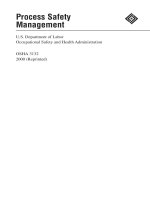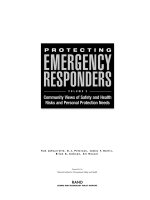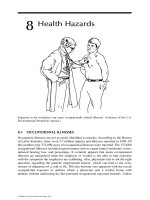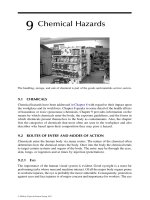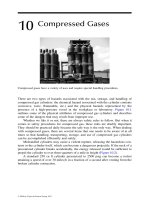HRM 5th chapter 12 safety and health
Bạn đang xem bản rút gọn của tài liệu. Xem và tải ngay bản đầy đủ của tài liệu tại đây (441.2 KB, 34 trang )
Safety and Health
Managing Human Resources
Belcourt * Bohlander * Snell
Copyright © 2008 by Nelson, a division of Thomson
Canada Limited.
All rights reserved.
5th Canadian edition
PowerPoint Presentation by
Monica Belcourt, York University and
Charlie Cook, The University of West Alabama
Objectives
After studying this chapter, you should be able to:
1. Summarize the common elements of federal and
provincial occupational health and safety
legislation.
2. Describe what management can do to create a safe
work environment.
3. Identify the measures that should be taken to
control and eliminate health hazards.
4. Describe the organizational services and programs
for building better health.
5. Explain the role of employee assistance programs
in HRM.
6. Indicate methods for coping with stress.
Copyright © 2008 by Nelson, a
12–2
Safety and Health: It’s the Law
Each year, there are over 900 workplace related
deaths.
There are over one million work related injuries.
There are 340,000 injuries serious enough that the
worker misses a day of work.
Annually, over 12 billion dollars is paid out to injured
workers and their families.
Copyright © 2008 by Nelson, a
12–3
Occupational Health and Safety
• Occupational Injury
Any cut, fracture, sprain or amputation resulting from
a workplace accident or from exposure involving an
accident in the work environment.
• Occupational illness
Any abnormal condition or disorder, other than one
resulting from an occupational injury, caused by
exposure to environmental factors associated with
employment.
Copyright © 2008 by Nelson, a
12–4
Acts and Regulations
• Canada Labour Code
• Provincial regulations
Every province and territory has regulations covering
occupational health and safety
Copyright © 2008 by Nelson, a
12–5
Duties of Employers
•
•
•
•
•
Provide a hazard free workplace.
Comply with statutes and regulations.
Inform employees about OH&S regulations.
Keep records and summaries.
Ensure supervisors and employees are familiar with
hazards.
• Report any accidents that cause injury and death.
Copyright © 2008 by Nelson, a
12–6
Duties of Workers
• Comply with all applicable acts and legislation.
• Report hazardous conditions and defective equipment.
• Follow all employer H& S rules, including the use of
protective equipment.
• The right to refuse unsafe work.
Copyright © 2008 by Nelson, a
12–7
Duties of Supervisors
• Advise employees of potential workplace hazards.
• Ensure that workers use or wear safety equipment,
devices and clothing.
• Provide written instruction where applicable.
• Take every reasonable precaution to guarantee the
safety of workers.
Copyright © 2008 by Nelson, a
12–8
Workers Compensation
• An injured worker can receive:
Cash pay-outs or wage loss payments
Unlimited medical aid
Vocational rehabilitation
Copyright © 2008 by Nelson, a
12–9
Creating a Safe Work Environment
Safety Motivation
and Knowledge
Safety Awareness
Programs
Elements in Creating a Safe
Work Environment
Enforcement of
Safety Rules
Copyright © 2008 by Nelson, a
Accident
Investigations
and Records
12–10
Creating a Safe Work Environment (cont’d)
• Promoting Safety Awareness
The Key Role of the Supervisor
Communicating
the need to work safely.
Proactive Safety Training Program
First aid, defensive driving, accident prevention
techniques, hazardous materials, and emergency
procedures.
Information Technology and Safety Awareness and
Training
Copyright © 2008 by Nelson, a
12–11
Creating a Safe Work Environment (cont’d)
• Typical Safety Rules
Using proper safety devices
Using proper work procedures
Following good housekeeping practices
Complying with accident- and injury-reporting
procedures
Wearing required safety clothing and equipment
Avoiding carelessness and horseplay
Copyright © 2008 by Nelson, a
12–12
Enforcing Safety Rules
• Actively encourage employee participation in the safety
program by:
Jointly setting safety standards with management.
Participation in safety training.
Involvement in designing and implementing special
safety training programs.
Involvement in establishing safety incentives and
rewards.
Inclusion in accident investigations.
Copyright © 2008 by Nelson, a
12–13
Investigating and Recording Accidents
• Recordable Case
Any occupational death, illness, or injury to be
investigated.
If the cause can be determined, then corrections must
be made to prevent it happening again.
Employers must keep record and compile and post
summaries of work related injuries and illnesses.
Copyright © 2008 by Nelson, a
12–14
Computing the Incidence Rate
• The following equation computes the incidence rate,
where 200,000 equals the base for 100 full-time workers
who work forty hours a week, fifty weeks a year:
Copyright © 2008 by Nelson, a
12–15
Health Hazards and Issues
Proliferating
Chemicals
Indoor Air Quality
Video Display
Terminals
Communicable
Diseases
Copyright © 2008 by Nelson, a
Cumulative Trauma
Disorders
12–16
Creating a Healthy Work Environment
• Recognizing and Controlling Health Hazards Related to
Hazardous Materials and Processes
Use substitutes for hazardous materials.
Alter hazardous processes and engineering controls.
Enclose or isolate hazardous processes.
Issue clothing to protect against hazards.
Improve ventilation.
Copyright © 2008 by Nelson, a
12–17
WHMIS
• Labels
• Material Safety Data Sheets
• Training
Copyright © 2008 by Nelson, a
12–18
Creating a Healthy Work Environment
(cont’d)
• Problems with Video Display Terminals (VDT)
Visual difficulties, muscular aches and pains, and job
stress
Solutions:
Place the computer screen 10 to 25 cm (4 to 9 inches) below
eye level.
Keep the monitor directly in front of you.
Sit in an adjustable-height chair and use a copyholder that
attaches to both the desk and the monitor.
Use a screen with adjustable brightness and contrast controls.
Use shades or blinds to reduce the computer-screen glare
created by window lighting.
Copyright © 2008 by Nelson, a
12–19
Creating a Healthy Work Environment
(cont’d)
• Cumulative Trauma Disorders (Repetitive Motion
Injuries)
Injuries involving tendons of the fingers, hands, and
arms that become inflamed from repeated stresses
and strains resulting from jobs requiring repetitive
motion of the fingers, hands, or arms.
Injuries lower employee productivity, increase
employer health costs, and incur workers’
compensation payments.
Copyright © 2008 by Nelson, a
12–20
Key Elements for a Successful Ergonomics Program
• Provide notice and training for employees.
• Conduct pre-injury hazard assessment.
• Involve employees.
• File injury reports.
• Plan and execute.
• Evaluate and assess the ergonomics program.
Figure 12.4
Copyright © 2008 by Nelson, a
12–21
Workplace Violence
• Reducing Violence in the Workplace
Commitment to prevent violence
Identify areas of potential violence
Develop violence prevention policies
Provide violence prevention training
Evaluate program effectiveness
Copyright © 2008 by Nelson, a
12–22
Violence Indicators: Know the Warning Signs
• Direct or veiled threatening statements
• Recent performance declines, including concentration problems and excessive
excuses
• Prominent mood or behaviour changes; despondence
• Preoccupation with guns, knives, or other weapons
• Deliberate destruction of workplace equipment; sabotage
• Fascination with stories of violence
• Reckless or antisocial behaviour; evidence of prior assaultive behaviour
• Aggressive behaviour or intimidating statements
• Written messages of violent intent; exaggerated perceptions of injustice
• Serious stress in personal life
• Obsessive desire to harm a specific group or person
• Violence against a family member
• Substance abuse
Sources: Adapted from Violence in the Workplace: Risk Factors and Prevention Strategies, NIOSH Bulletin
#59; Gillian Flynn, “Employers Can’t Look Away from Workplace Violence,” Workforce 79, no. 7 (July 2000):
68–70; Dannie B. Fogleman, “Minimizing the Risk of Violence in the Workplace,” Employment Relations
Today 87, no. 1 (Spring 2000): 83–98.
Copyright © 2008 by Nelson, a
Figure 12.5
12–23
Terrorism
• To deter terrorist attacks:
Heighten ID checks and baggage screening
Increase video monitoring with threat-recognition
software to back up human surveillance
Install blast-resistant glass to reduce casualties
Have offsite emergency offices
Tighten garage security with stepped-up inspections
Stagger deliveries to reduce truck traffic
Develop emergency evacuation procedures, including
escape routes, emergency equipment, and gathering
locations
Copyright © 2008 by Nelson, a
12–24
Crisis Management Teams
• Teams composed of both hourly and managerial
employees:
Conduct initial risk assessment surveys
Develop action plans to respond to violent situations
Perform crisis intervention during violent, or
potentially violent, encounters
Copyright © 2008 by Nelson, a
12–25

